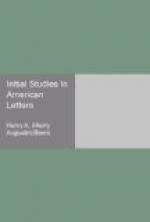“Tales that have the rime of age
And chronicles of eld.”
The golden light of romance is shed upon his page, and it is his habit to borrow mediaeval and Catholic imagery from his favorite Middle Ages, even when writing of American subjects. To him the clouds are hooded friars, that “tell their beads in drops of rain;” the midnight winds blowing through woods and mountain passes are chanting solemn masses for the repose of the dying year, and the strain ends with the prayer—
“Kyrie, eleyson,
Christe, eleyson.”
In his journal he wrote characteristically: “The black shadows lie upon the grass like engravings in a book. Autumn has written his rubric on the illuminated leaves, the wind turns them over and chants like a friar.” This in Cambridge, of a moonshiny night, on the first day of the American October! But several of the pieces in Voices of the Night sprang more immediately from the poet’s own inner experience. The Hymn to the Night, the Psalm of Life, The Reaper and the Flowers, Footsteps of Angels, The Light of Stars, and The Beleaguered City spoke of love, bereavement, comfort, patience, and faith. In these lovely songs, and in many others of the same kind which he afterward wrote, Longfellow touched the hearts of all his countrymen. America is a country of homes, and Longfellow, as the poet of sentiment and of the domestic affections, became and remains far more general in his appeal than such a “cosmic” singer as Whitman, who is still practically unknown to the “fierce democracy” to which he has addressed himself. It would be hard to overestimate the influence for good exerted by the tender feeling and the pure and sweet morality which the hundreds of thousands of copies of Longfellow’s writings, that have been circulated among readers of all classes in America and England, have brought with them.




